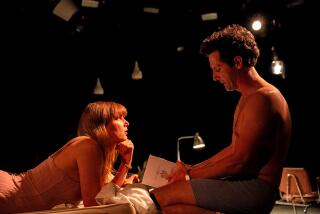TV Reviews : ‘American Indian Dance Theatre’ on Channel 28
- Share via
No one-hour telecast can rectify all the neglect and misunderstanding suffered by Native American culture--and by assuming this mission, “American Indian Dance Theatre: Finding the Circle” spreads itself painfully thin.
This conceptually flawed, lavishly produced PBS “Dance in America” episode airs tonight at 9 on Channels 15 and 24, at 10 on Channel 28 and Sunday at 10 p.m. on Channel 50.
On top of a scenically enhanced, studio-taped version of what the three-year-old company does on stage, the program layers narration explaining the ceremonial context of the various pieces--plus reminiscences by members of the company.
All this talk scarcely allows deep concentration on either the powerful dancing or the brilliant design motifs of traditional Indian dance-costumes. There are two parallel experiences here--one artistic, one anthropological--and just how does an audience new to Indian dance absorb both at once?
In addition, there’s a brief foray into movement analysis midway through, along with documentary footage (shot in Oklahoma and New Mexico) that doesn’t mesh with the stylized studio sequences. Director Merrill Brockway often sends his cameras swooping among the dancers, losing as much of a piece as he manages to record. “The Eagle Dance” is especially problematic in this regard--and it also features high camera angles that photographically pin the eagles to the floor.
Although “Finding the Circle” is filled with the beauty, virtuosity and insight of major artists--some of them champions known throughout the Indian dance world--the performers are never named except for an alphabetical list in the final credits. This is very peculiar. Would “Dance in America” fail to identify Maria Tallchief, a great Indian dancer who made her career in ballet?
Of course not.
So why can’t the series credit Eddie Swimmer with his spectacular hoop solo?
Like the atmospheric prologue to “Finding the Circle,” much Indian dance explores the relationship between a dancer and a drum. Despite its emphasis on fancy-dan photography and background information, this program often fails to show us that dancing clearly, to let us hear that drum--or even to tell us who we’re seeing.
More to Read
The complete guide to home viewing
Get Screen Gab for everything about the TV shows and streaming movies everyone’s talking about.
You may occasionally receive promotional content from the Los Angeles Times.






